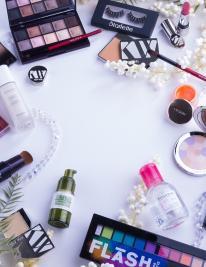
Doctors and patients rarely discuss the relationship between cosmetics and dry eye symptoms. Despite the fact that here are very real health implications associated with everyday beauty practices. Doctors typically focus on the findings uncovered during the exam and appropriate treatment options. Patients often do not think about the potential affects their cosmetics can cause to their dry eyes. Hopefully, this blog will provide useful information for patients before they make their next trip to the cosmetic department at their favorite store.
There are a number of ingredients within cosmetic products that are known irritants to the ocular surface, some of which are actually toxic. The FDA regulates cosmetic products, but with a lighter hand than other countries. In fact, the FDA bans less than 0.01% of the products banned by the European Union. These ingredients play various roles in cosmetics from improving adhesion upon application, allowing ingredients to better mix together and as a preservative to a product.
It is important to read the label on your cosmetics to ensure that you minimize their impact on the ocular surface. Parabens are a common preservative in many skin care and cosmetic products. They are toxic to our meibomian glands within the eyelid, which are responsible for producing the oily component of our tear film. Many of the liquid solutions used to remove makeup contain benzalkonium chloride (BAK), which is known to be detrimental to both the cells on the corneal surface and superficial cells over the white part of the eye.
Many will notice that removing their eye makeup before they go to bed leads to less irritated eyes the next day. Dry eye patients will often gravitate to waterproof mascara due to the tearing associated with their dry eye. They will then need to use liquid makeup removal, such as discussed earlier, with BAK to remove their mascara. As one can see, this can lead to a cycle that only makes one’s dry eye symptoms worse in the end.
Another potential hazard for dry eye suffers are eyelash growth serums and synthetic eyelash extensions. Many of the eyelash growth serums contain ingredients that while causing eyelashes to grow also cause inflammation of the tissue around the lashes that can lead to a worsening of dry eye symptoms and increased redness of both the eye and skin around the eye. The chemicals within the adhesives used to apply lash extensions can cause both inflammatory and allergic reactions.
There can be a real cost to beauty. Sometimes it can be a matter of trial and error, but the following are a list of the top offenders to avoid for patients with dry eye:
• Waterproof eye makeup
• Liquid eye makeup removers
• Eyelash extensions
• Eyelash growth serums
• Eyeliner applied inside the lashes, between the base of the lashes and the eye
If you have any questions regarding dry eye or any other eye conditions, the doctors at Summit Eye Center are available to help. You can call Summit Eye Center at (816) 246-2111 or email at